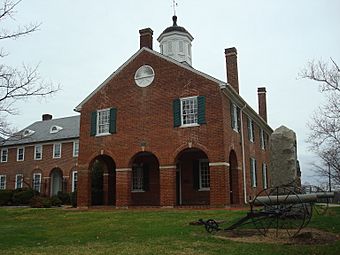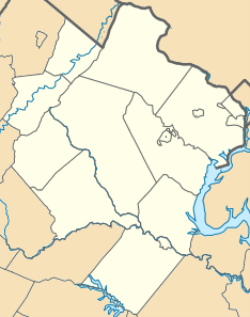Historic Fairfax County Courthouse facts for kids
|
Fairfax County Courthouse
|
|
|
U.S. Historic district
Contributing property |
|

Outside view of Fairfax County Courthouse, Fairfax, VA.
|
|
| Location | 4000 Chain Bridge Road Fairfax, Virginia |
|---|---|
| Area | less than one acre |
| Built | 1799 |
| Architect | James Wren |
| Architectural style | Early Republic, Roman Revival |
| NRHP reference No. | 74002235 |
Quick facts for kids Significant dates |
|
| Added to NRHP | May 03, 1974 |
The Historic Fairfax County Courthouse is a very old building in Fairfax, Virginia. It was built in 1799. Its purpose was to be the main office for the county's leaders.
During the American Civil War, a sad event happened here. The first officer from the Confederate side to die in the war was killed on the courthouse grounds. Both sides in the war used the building at different times. Today, the original courthouse is part of a bigger courthouse area. This area helps run the local government of Fairfax County.
Contents
How Fairfax County's Courthouse Began
When Virginia started its county court system in 1619, these courts handled important tasks. They decided local taxes and gave out permits for businesses. They also planned roads and generally ran the local government. Fairfax County built its first courthouse in 1742. It was at a place called "Spring Field," near what is now Tysons Corner.
By the mid-1700s, Alexandria became a big port city. So, in 1752, the courthouse moved there. In November 1789, people in Fairfax County decided they needed a new courthouse. They asked the government to build it in the center of Fairfax County. This would make it easier for everyone to reach. It would also help local businesses grow.
Soon after, the court ordered a special collection. Each person who paid taxes had to give thirty-five cents. This money would pay for building the new courthouse. Business owners near the planned site were happy. They believed the new courthouse would bring more customers.
The current spot for the courthouse was chosen. It was bought from Richard Ratcliffe for just one dollar. In May 1799, the land was ready. The court then ordered the construction of several buildings. These included a courthouse, a jail, a clerk's office, and a jailer's house. The clerk's office roof was to be "arched over with Slate or Tile." This was likely to protect it from fire. There were also plans for stocks, a pillory, and a whipping post. John Bogue and Mungo Dykes were hired to build them. The main designer of the building was James Wren.
Who Was James Wren?
James Wren was born in King George County, Virginia, in 1728. He learned carpentry skills there. In 1755, he moved to Fairfax County. He served as a judge on the Fairfax County Court. His name appears often in county records from the 1700s.
By the end of the 1700s, he was known as a skilled architect. He designed the Falls Church and Christ Church in Alexandria. Wren became a Methodist. Two of his daughters married Methodist ministers. His second wife, Sarah, made plans for some of their family's slaves to be freed. This would happen when they grew up and got an education. The rest of the Wren family slaves were freed after Sarah died. Some former slaves even bought items from the Wren family's estate.
The Courthouse Before the Civil War
The District of Columbia was created in 1800. In March of that year, a notice was sent out. It said the County Court would meet at the new courthouse. This new location was in "the center of the County." Everyone with business there was asked to come on the third Monday of April.
On April 21, the first court session happened in the new building. The first thing they did was record the will of Corbin Washington. He was the nephew of George Washington. He was also the brother of Judge Bushrod Washington, a Supreme Court Justice. James Wren's design for the new courthouse was different. Most Virginia courthouses were one story. His design had two stories. The courtroom was on the first floor. Jury rooms were above it.
We don't have exact descriptions of the inside of the courthouse. But it was common for a large table to be in the middle of the main room. This table was usually big enough for the sheriff and county judges. The courthouse likely had this setup. There was also usually a wooden railing. This separated the public area from the court. Fireplaces probably heated the courtroom and the jury room upstairs.
The new courthouse area slowly became the center of activity for the county. In 1805, the area around it was named the Town of Providence. The courthouse location was perfect. It was where Little River Turnpike and Ox Road met. These are now routes 236 and 123. This made it easy to reach from most parts of the county.
Lawyers often rented rooms in the Willcoxon hotel nearby. They used these as their offices. They advertised their services in the Alexandria Gazette. The town of Providence was called Fairfax Court House during the Civil War. It became the Town of Fairfax in 1875.
By the early 1800s, the land around the courthouse was flat. A fence was built around the property. In December 1802, officials made a rule. It stopped people from selling drinks on the public lot. In 1803, a plan for a poorhouse was presented. One was soon built, and land was set aside for it. Gallows were set up at "Race Field." This was on land owned by Richard Ratcliffe. In 1810, the old jail on the courthouse grounds burned down. A new jail was built for $2,486.
Court cases often showed what life was like back then. For example, John Hugely came to court. Two witnesses said the top of his left ear was bitten off in a fight. Another man, William Johnston, was accused of stealing clothes. He was sentenced to ten lashes at the public whipping post.
One way people in Fairfax made money was by selling or hiring out their extra slaves. Slave auctions were often held at the front door of the courthouse. In 1800, Reverend Jeremiah Moore was allowed to preach in the courthouse. In 1801, Black people were not allowed to play games inside the courthouse area.
New roads were built connecting Alexandria and Washington to the Shenandoah Valley. This made the courthouse square even busier. Business people met others there. People came to share news and see friends. In the 1800s, much of rural Virginia's social and economic life happened around these "court days."
The Courthouse During the Civil War
About three hundred people lived near Fairfax Court House when the American Civil War started in April 1861. That same month, a group of soldiers called the Fairfax Rifles joined the army. They gathered on the courthouse grounds. In May, a small group of Confederates took control of Fairfax Court House. They were led by Lieutenant Colonel Richard Ewell.
One group of Confederates camped at the Zion Church. Another group camped on the courthouse lot. A third group, led by Captain John Quincy Marr, camped at a Methodist church south of the courthouse. Captain Marr was in charge of about ninety men. They were called the Warrenton Rifles. On the night of May 31, he was sleeping in the clerk's building on the courthouse grounds.
The First Confederate Officer to Die
A group of about eighty Union cavalry soldiers were scouting the area. This was on the evening of May 31. Around 3 AM, Confederate guards outside town met the cavalry. The Southern troops were forced to retreat. As the Union cavalry got close to the courthouse, a fight started with the Confederate soldiers there.
There was a lot of confusion during the fight. At some point, Captain Marr was killed. A local slave found his body on the courthouse grounds the next morning. People still wonder how he died. Some historians think a stray bullet hit him. Others even say it was from his own side. No matter how it happened, Captain Marr was the first Confederate officer to die in the American Civil War.
When the Courthouse Changed Hands
The courthouse first came under Union control a month later. Union General Irvin McDowell moved his army toward Manassas on July 18, 1861. Manassas would be the site of the first major battle of the war. By spring 1862, the courthouse was no longer used for legal business. It was just a military outpost.
Fairfax Court House was controlled by Southern troops again for part of 1862. But by the end of that year, Union troops had control again. They kept it until the war ended. Old photos show the courthouse being used as a lookout point for Union patrols. Other stories say the courthouse was badly damaged. Its furniture was removed, and the inside was mostly empty.
For much of 1863 and 1864, the courthouse was a military outpost. It was a small headquarters for the Union army. They used it to protect their supply lines from small groups of enemy soldiers. Many important legal documents from Fairfax County were destroyed during the war.
One very important item was saved. When Confederate troops left Fairfax Court House in fall 1861, George Washington's will was there. The court clerk, Alfred Moss, secretly took it out of the building. He took it to Richmond, Virginia, for safekeeping. After the Civil War, it was returned to Fairfax.
Martha Washington's will was also at the courthouse. It was not removed. It stayed there while Union troops occupied the building. In late 1862, soldiers were cleaning out the building. A Union lieutenant became curious about some papers. He realized some were Martha Washington's will. So, he took it with him. The will appeared again in 1903 in England. The lieutenant was said to have sold it to a man named J.P. Morgan. The will stayed with the Morgan family. It was returned to Fairfax County sometime in the 1900s.
After the War to the 1900s
During the later years of the Civil War, Union troops used the jail next to the courthouse. It was a storage place and held military prisoners. A fire destroyed the jail in 1884. A new one was built a year later. The jailer lived in the front part of this new building until 1948. The building stopped being used for prisoners soon after that.
Since 1956, the old jail building has been used for county offices. These include the juvenile court, probation office, and recreation department. In the last century, the courthouse area changed. New parts were added to the old 1800 building. These additions were built in 1929 and 1953. They made the courthouse a large E-shaped building. During these changes, a small brick office was torn down. It was built in 1870 for the Clerk of the Court.
For a while, all major county offices were in the new courthouse additions. In 1969, a fifteen-story county office building was built. It is southwest of the old courthouse. It provides space for the Board of Supervisors and many county offices. Besides holding courts, the courthouse also stores records of deeds and wills. The original wills of George and Martha Washington are currently on display. You can see them in the County Court Clerk's office. The Historic Fairfax County Courthouse and Jail were added to the National Register of Historic Places in 1981. It is located in the City of Fairfax Historic District.
The Historic Courthouse Today
Today, the original courthouse building and its additions are still used. They serve the Circuit Court, General District Court, and Juvenile and Domestic Relations courts of Fairfax County.







